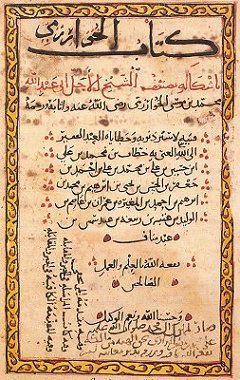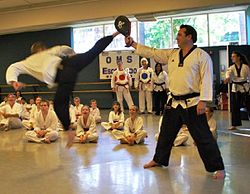Sejarah matematika
Halaman dari Buku Ikhtisar Perhitungan dengan Penyelesaian dan Perimbangan karya Muḥammad bin Mūsā al-Khawārizmī (sekitar 820 Masehi)
Cabang pengkajian yang dikenal sebagai sejarah matematika adalah penyelidikan terhadap asal mula penemuan di dalam matematika dan sedikit perluasannya, penyelidikan terhadap metode dan notasi matematika pada masa silam.
Sebelum zaman modern dan penyebaran ilmu pengetahuan ke seluruh
dunia, contoh-contoh tertulis dari pengembangan matematika telah
mengalami kemilau hanya di beberapa tempat. Tulisan matematika terkuno
yang telah ditemukan adalah Plimpton 322 (matematika Babilonia sekitar 1900 SM),[1] Lembaran Matematika Rhind (Matematika Mesir sekitar 2000-1800 SM)[2] dan Lembaran Matematika Moskwa (matematika Mesir sekitar 1890 SM). Semua tulisan itu membahas teorema yang umum dikenal sebagai teorema Pythagoras, yang tampaknya menjadi pengembangan matematika tertua dan paling tersebar luas setelah aritmetika dasar dan geometri.
Sumbangan matematikawan Yunani memurnikan metode-metode (khususnya melalui pengenalan penalaran deduktif dan kekakuan matematika di dalam pembuktian matematika) dan perluasan pokok bahasan matematika.[3] Kata "matematika" itu sendiri diturunkan dari kata Yunani kuno, μάθημα (mathema), yang berarti "mata pelajaran".[4] Matematika Cina membuat sumbangan dini, termasuk notasi posisional. Sistem bilangan Hindu-Arab
dan aturan penggunaan operasinya, digunakan hingga kini, mungkin
dikembangakan melalui kuliah pada milenium pertama Masehi di dalam matematika India dan telah diteruskan ke Barat melalui matematika Islam.[5][6] Matematika Islam, pada gilirannya, mengembangkan dan memperluas pengetahuan matematika ke peradaban ini.[7] Banyak naskah berbahasa Yunani dan Arab tentang matematika kemudian diterjemahkan ke dalam bahasa Latin, yang mengarah pada pengembangan matematika lebih jauh lagi di Zaman Pertengahan Eropa.
Dari zaman kuno melalui Zaman Pertengahan, ledakan kreativitas
matematika seringkali diikuti oleh abad-abad kemandekan. Bermula pada abad Renaisans Italia pada abad ke-16, pengembangan matematika baru, berinteraksi dengan penemuan ilmiah baru, dibuat pada pertumbuhan eksponensial yang berlanjut hingga kini.
Sumber : Wiki










